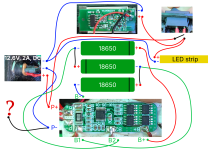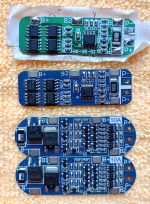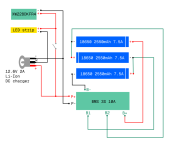Hi!
I think this is a simple question for professionals but I can't figure it out by myself.
I connected 3 pieces of 18650 cells, BMS 3S 10A board, that indicator and the LED strip. It all works fine except one thing: batteries won't charge. Batteries and the BMS board are brand new. Batteries are refurbished though. But anyway. There was one black wire soldered to P- at one end, and I can't figure out where was the other end soldered, but I believe that's the reason why the batteries won't charge. Anyone with an idea please?

I think this is a simple question for professionals but I can't figure it out by myself.
I connected 3 pieces of 18650 cells, BMS 3S 10A board, that indicator and the LED strip. It all works fine except one thing: batteries won't charge. Batteries and the BMS board are brand new. Batteries are refurbished though. But anyway. There was one black wire soldered to P- at one end, and I can't figure out where was the other end soldered, but I believe that's the reason why the batteries won't charge. Anyone with an idea please?




